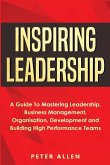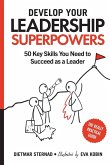In order to be an effective leader, you need to be able to gain power within the group structure. But not just any power will do. You need to invite collaborative power from the senior leaders above you, you need to attract that collaborative power from everyone that follows you, and you need to cultivate power from the larger landscape. What's different in my approach, as being not only a leadership expert but a leadership training expert is I give my students the exact step-by-step process of what they need to do leaving nothing up for interpretation and making sure (what is a very complicated process) is now broken down into A) very easily understood and B) very easy to implement actions called Starting Now actions. With a five-step Starting Now process I teach leaders how to develop a mentoring and supportive relationship with their immediate senior supervisor. With a 10-step Starting Now process I teach the same leaders how to support their followers to create super effective mission-centered outcomes resulting in significantly less direct supervision over time. The results: Immediately using the Starting Now actions in Chapter 2 and in the sequence as laid out in chapter 1, these are the trends you will be setting in place that will mature over time: Examples of negative human behaviors drop Fear-caused behaviors drop Quality and quantity of communication increases Mission statement moves to center stage Respect and dignity become preferred behaviors Professional relationships dominate Clear and achievable performance expectations abound Leadership provides a support role without giving up power Problem-solving becomes a team sport Productivity and smart work rules over mediocrity Group members become involved in creating outcomes Inappropriate, toxic behaviors are trounced Group members accept more responsibility over time Ability to deal with adversity increases Ideas for improvement are a constant conversation Team members become very good at what they do Leaders grow to very high levels of effectiveness Group members have the confidence to make decisions and know when to include their supervisor Continuous improvement strategy becomes an organic function The need for direct supervision continuously dries up Leaders learn to check their ego at the door After Chapters 1 and 2 are implemented you can read the rest of the book. Once Chapters 3 through 7 are fully implemented along with the expertise and knowledge base you have gained, these are the results you will gain over time as the group matures: Identifying a list of behaviors to stop using if you want more group collaboration Implementing a list of behaviors to start using if you want more group collaboration Smartly addressing and eliminating the causes of fear generated in the work environment Reducing the complexity of the policies, procedures, and how-to of day-to-day operations Training every group member to expert levels in collaboration and technical competency Reducing expensive direct supervision time by providing more autonomy Creating clearly understood objectives that are directly supported by that person's training Ensuring smooth productivity by removing roadblocks, adjusting workloads, and setting reasonable deadlines with clear expectations as part of every delegated task Having leaders conscientiously train, mentor, and guide the success behaviors of their direct reports








